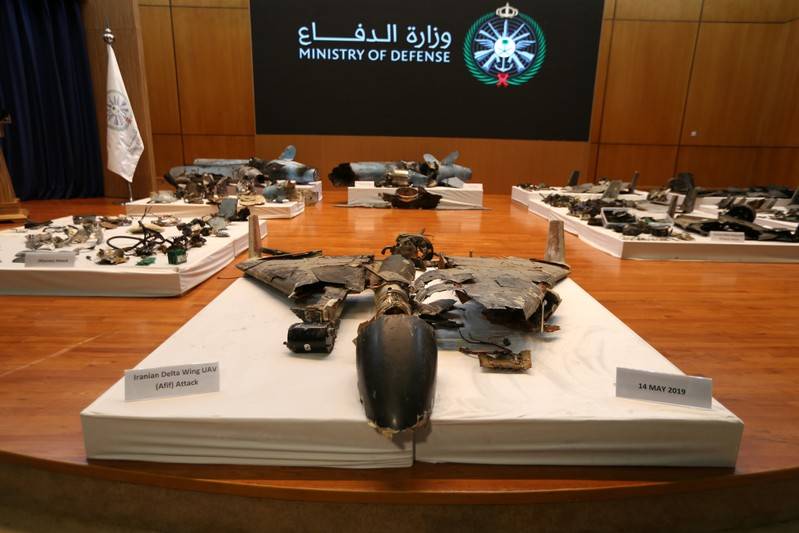FRESH AIR
Israel prepares to counter drones and cruise missiles from Iran and its proxies
November 8, 2019 | Oved Lobel

The September 14 precision attacks against Saudi Arabian oil processing facilities, the world’s largest, knocked out about half of Saudi output and between five and six percent of global oil supply. This attack, which all knowledgeable sources attribute to Iran, should have woken the world up to the danger of Iran’s cruise missile and drone capabilities and proliferation of these systems to its proxies.
In Israel, Army Radio recently reported that the country is bracing for similar attacks, citing several anonymous sources. While the Saudi attack was much larger and more sophisticated than any previous attacks attributed to Iran or its proxies, it was foreshadowed by what the IDF claims was an Iranian plan to fly multiple ‘kamikaze drones’ into targets in Israel in late August. According to the IDF, four advisers from Iran’s Islamic Revolutionary Guard Corps (IRGC) flew into Syria via Lebanon with the attack drones in the weeks prior to the attack. Israel monitored and then bombed the drone base, after having foiled a previous attempt to launch drones into Israel the week before.
Although Israel had reportedly been striking Iranian missile shipments to Hezbollah, Iran’s proxy in Lebanon, since at least 2012, it was an alleged incursion into Israeli airspace by an Iranian drone in 2018 that sparked the first massive wave of airstrikes on Iranian facilities in Syria. More recently, following the foiled attacks in August, a murky incident involving two drones crashing into Hezbollah targets in Beirut – allegedly including vital equipment for Hezbollah’s precision missile conversion project – sparked one of the first exchanges of fire between Israel and Hezbollah in Lebanon since 2006.
In May, Iran’s Gaza-based proxy Palestinian Islamic Jihad released footage of its armed drones dropping munitions on IDF vehicles, adopting the low-cost, high-impact tactics of rebel groups against the Russians in Syria and by Islamic State against various targets throughout Syria and Iraq. Hamas, the most powerful group in the Gaza strip and also an Iranian proxy, operates a cheap air force of consumer-grade drones modified to carry explosives, as well. Israel is suspected of being behind the assassinations of two Hamas engineers working to improve their drone program, including Mohammed Zawahri in December 2016 in Tunisia and Fadi al-Batash in Malaysia in April 2018.
Like many countries involved in combat in the Middle East, Israel is scrambling to devise cost-effective countermeasures to the varying types of drone threats. What it costs Iran and its proxies to produce or acquire dozens of cheap attack drones is a pittance compared to the cost of a single Israeli missile used to intercept them, and a large salvo of cruise missiles and drones could quickly overwhelm Israel’s current defence systems. Hamas and Islamic Jihad have also been able to fly explosive drones, which cost as little as $200, into Israel repeatedly, and when they are detected, shooting them down with missiles is prohibitively expensive if done on a large scale.
To make matters worse, even this unsustainable method isn’t guaranteed to be successful against individual drones. In 2016, a single Russian drone penetrated four kilometres into Israeli airspace, and despite three attempts to shoot it down – including two Patriot missiles as well as an air-to-air missile – it managed to escape unscathed. In 2018, an unarmed drone, allegedly Syrian, flew 10 kilometres into Israel for unclear reasons before eventually being shot down by a Patriot battery.
But Israeli companies are at the forefront of developing various countermeasures, some of which are being adopted by the US military. As Anna Ahronheim summarised recently, Israeli companies have developed both kinetic and electronic counter-drone options. For instance:
- Smart Shooter produces the SMASH 2000 fire control system, which uses advanced algorithms to guarantee hits against small moving targets like drones and is used by both the IDF as well as the US military.
- Other companies, like ORAD, have produced the DROM Drone Defence System, which can electronically detect, hijack, and land enemy drones from distances of over 3 kilometres.
- Another Israeli company focused on counter-drone measure, D-Fend Solutions, has systems like the EnforceAir c-UAS, which also identifies, hijacks, and lands enemy drones. This system was recently selected by the US military’s Defense Innovation Unit.
- There are also entire “end-to-end” systems for detection and destruction through both kinetic and electronic means, such as Rafael’s Drone Dome.
- Israel Aerospace Industries has created the Popstar system, able to detect drones from several kilometers away and differentiate them from regular commercial traffic in vital areas.
- The Israeli company Vorpal is developing a system to detect drones and their operators in high-density urban areas within two seconds.
Given that Israel was the first country to use drones for real-time targetting on a large scale, it makes sense they’d also be at the forefront of developing countermeasures.
Of course, Israel is not the only country facing the threat of drone proliferation to insurgents and terrorist groups. The US is reportedly deploying a prototype of Raytheon’s Phaser high-power microwave counter-drone system outside the country for testing following the attack on Saudi Arabia and the failure of its defence systems, and US companies are also working on systems to defeat the substantial drone threat they faced from Islamic State. Russia, on the other hand, seems to be relying on brute-force in dealing with its problem of rebel drones dropping bombs on its airbase in Syria, by deploying multiple layers of anti-air defence capabilities.
Countering Cruise Missiles
In late October, it was reported that Israel had updated its Barak MX air defence system with new Barak-8 Extended Range interceptors, increasing the range of the system to 150km. According to Boaz Levy, the vice-President of Israel Aerospace Industries and general manager of its missiles and space division, the system, currently deployed on Israel’s Sa’ar-class corvettes, may be capable of defending Israeli cities from cruise missiles, the other key component of the Iranian attack on Saudi Arabian facilities in Khurais in September. This would theoretically add to Israel’s multi-layer missile defense system, including David’s Sling and Iron Dome, which also allegedly have some capability against cruise missiles.
No military force, however, has demonstrated an operational capability to consistently shoot down cruise missiles, and certainly not a barrage of them. For a variety of reasons, including their small radar signature, the ability to fly at very low altitude, and high manoeuvrability, they are qualitatively more difficult than rockets or drones to shoot down. Saudi Arabia, which spends billions of dollars on US missile defence systems, was unable to shoot down or apparently even track a single one of the projectiles launched against its facilities – though there are allegations that the systems were being improperly deployed and poorly manned at the time. None of Saudi Arabia’s air defence systems are designed specifically for this threat, although the US has still opted to send more of them as a response.
The US military, itself unprepared for the cruise missile threat, is trying to implement the Integrated Air & Missile Defense Battle Command System (IBCS), which won’t enter service until at least 2022, to network all of its various sensor and anti-air capabilities. This year, the US army purchased two Iron Dome batteries for interim cruise missile defence capability as it refocused its Indirect Fire Protection Capability (IFPC) program on cruise missile defence. Laser technology for cruise missile defence, long desired by all services in the military, likely remains a long way off.
Russia also has no reliable defence against cruise missiles. Despite a multi-layered network of short, medium, and long-range missile defence systems in Syria, and many untruths about them, there is no evidence any of its systems, even the purpose-built ones, can track or shoot down cruise missiles. Its electronic warfare systems are also not necessarily reliable against cruise missiles, although Iranian missiles are probably less sophisticated than American ones and Israel’s electronic warfare capabilities are likely more advanced than Russia’s.
Each type of drone and missile threat merits a different response. While Israel is not Saudi Arabia – which doesn’t really have a reliable and properly functioning military and lacks the independent capability to use many of the systems and munitions it possesses without Western technicians – it is not clear whether effective defence is even possible against a simultaneous attack consisting of dozens of low-flying Iranian cruise missiles and suicide drones launched from Lebanon, Syria, Iraq, and possibly Yemen. Israel has an advantage in that it has very little airspace to cover, but its vital infrastructure is still vulnerable.
Thus far, Israeli intelligence has managed to thwart several Iranian drone attack plans and Israel is also seeking to deter such attacks by signalling Iranian forces responsible will pay a heavy price given Israeli command of the air. Yet Israeli technological innovation generating even more effective defensive and offensive options remains very important to provide a fallback in case the Iranians do finally stage a significant attack.























